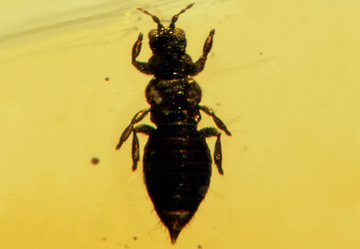Abstract
Paleoentomologists well know that the examination of fossil insects in amber is often complicated. Even if the amber is well-polished, the presence of small scratches at the surface and inner impurities generates reflections that limit observations. Prominent characters for taxonomy thus may not be visible even when preserved. Several solutions have been proposed to enhance the observation of fossil insects in amber. Most of them aim at limiting the number of optical medium interfaces, and thus reducing optical artefacts such as refraction and reflection. For example, amber may be embedded in Canada balsam or artificial resins (Azar & Nel, 1998; Green, 2001; Sidorchuk, 2013; Penney & Jepson, 2014; Sidorchuk & Vorontsov, 2018). However, these methods limit viewing angles and thus the observation of characters, are technically challenging and often irreversible. Another type of method is to immerse the piece of amber in a liquid with a refractive index as close as possible to the amber, such as sugared water, or oils (Sidorchuk, 2013). In this case, the interface between the objective lens and the amber is the coverslip that is placed on the surface of the liquid in order to avoid reflection on the water surface. Compounding the difficulty in observation is that an immersed piece of amber is observable only from one angle at a time, and the whole setting must be dismantled and reassembled to manually change the observation angle, which can result in a lengthy procedure.
References
Azar, D. & Nel, A. (1998) Preparation and preservation of fossil inclusions in amber. 1st World Congress on Amber Inclusions, Alava, Posters, p. 137.
Green, O.R. (2001) Preparation of amber specimens containing fossils. In: Green, O.R. (Ed.), A manual of practical laboratory and field techniques in palaeobiology. Springer, Dordrecht, pp. 234–241.
https://doi.org/10.1007/978-94-017-0581-3_23
Penney, D. & Jepson, J.E. (2014) Fossil insects. Siri Scientific Press, Manchester, 1–223.
Sidorchuk, E.A. (2013) A new technique for the preparation of small-sized amber samples with application to mites. In: Azar, D., Engel, M.S., Jarzembowski, E., Krogmann, L., Nel, A. & Santiago-Blay, J. (Eds), Insect evolution in an amberiferous and stone alphabet. Proceedings of the 6th International Congress on Fossil Insects, Arthropods and Amber, pp. 189–201.
https://doi.org/10.1163/9789004210714_014
Sidorchuk, E.A. & Vorontsov, D.D. (2018) Preparation of small-sized 3D amber samples: state of the technique. Palaeoentomology, 1, 80–90.


